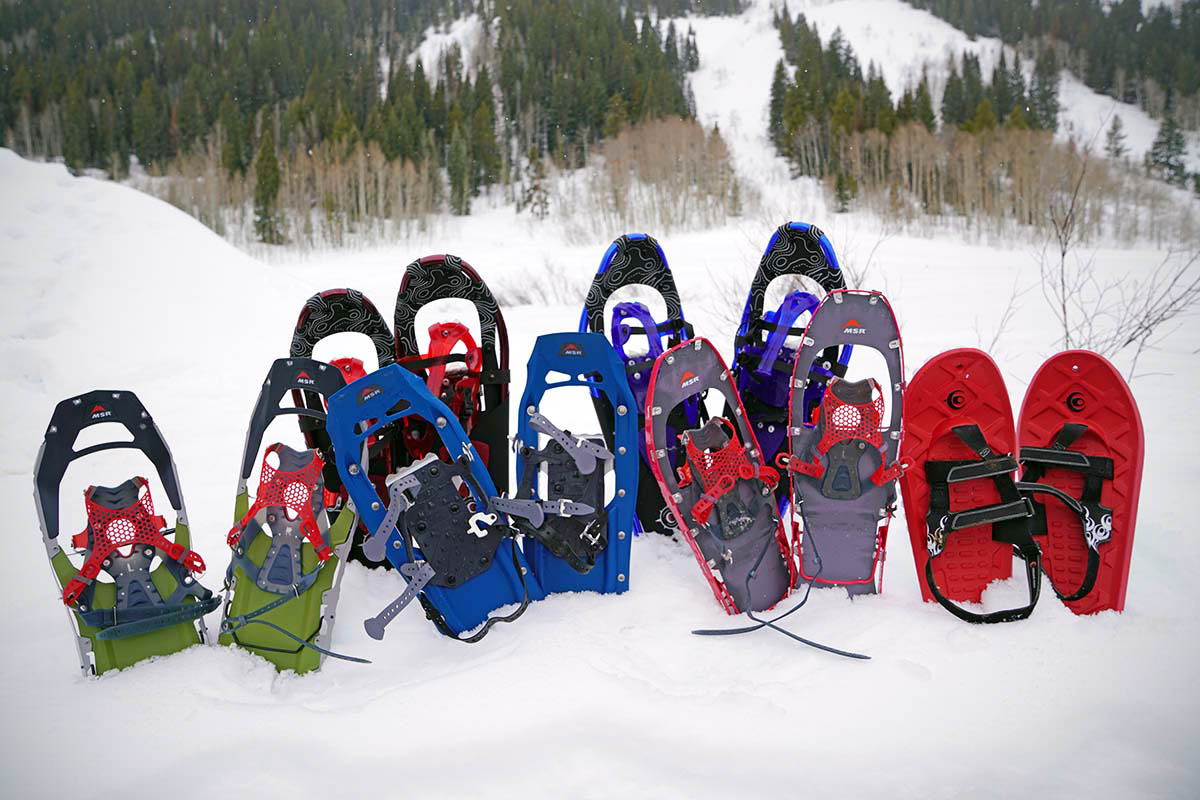
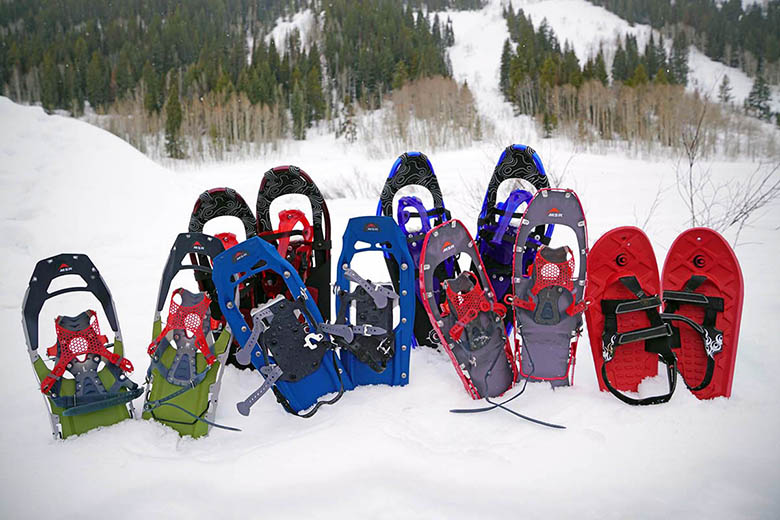
Switchback Travel


Switchback Travel
With a long platform for floatation and added traction underfoot, snowshoes open up your favorite terrain and hiking trails for all kinds of winter fun. Below we break down the best models for 2024, including top trail/recreational snowshoes, powder-ready backcountry models, and specialized running designs. The good news is that there is no shortage of quality options from brands like MSR, Atlas, Tubbs, TSL, and more. For more background information, see our snowshoe comparison table and buying advice below the picks.
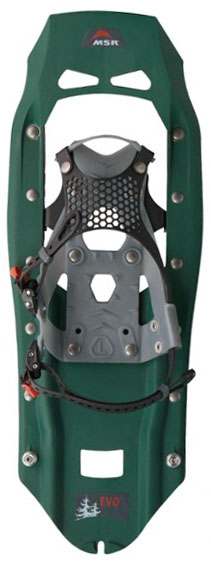 Category: Trail
Category: Trail
Length: 22 in. (6-in. tails optional)
Weight per pair: 3 lb. 10 oz.
What we like: A well-rounded and well-built snowshoe at an excellent value.
What we don’t: Plastic decking can be noisy; on the short side for powder (tails sold separately).
The Lightning Ascent below may be MSR’s top snowshoe in terms of performance, but it’s a steep investment at $390 and overkill on easy to moderate terrain. Enter MSR’s own Evo Trail, which will save you a whopping $220 while still checking all of the boxes for trail/recreational use, including durable hard plastic decking and impressive traction with solid toe crampons and side rails made of steel. MSR also upgraded the bindings recently, and the latest Paraglide design offers far better comfort and security than the past generation’s basic strap system. The Evo Trail still is on the short side for powder at 22 inches, but optional 6-inch tails ($55) can be attached to the back to improve performance in softer and deeper snow. Added up, it’s a very capable and affordably priced design and what we recommend to friends and family interested in mostly casual use.
What complaints do we have about the MSR Evo Trail? The plastic decking is reasonably tough and fine for shorter winter jaunts but can be noisy when walking on hardpack. It also isn’t as flexy as some of the pricier options here, and the raised front can potentially can break if someone steps on it the wrong way. In addition, heel lifters are not included, which can be helpful on prolonged climbs to limit calf fatigue. If this feature is a must-have for you, we recommend checking out MSR’s upgraded Evo Ascent model ($240). But again, we love the combination of price and quality of the Evo Trail, and it should be more than enough snowshoe for most. MSR also offers a prepackaged Evo Trail kit for those just getting started, which includes snowshoes, poles, a thin foam seat, and a carry bag for $290.
See the MSR Evo Trail Snowshoe
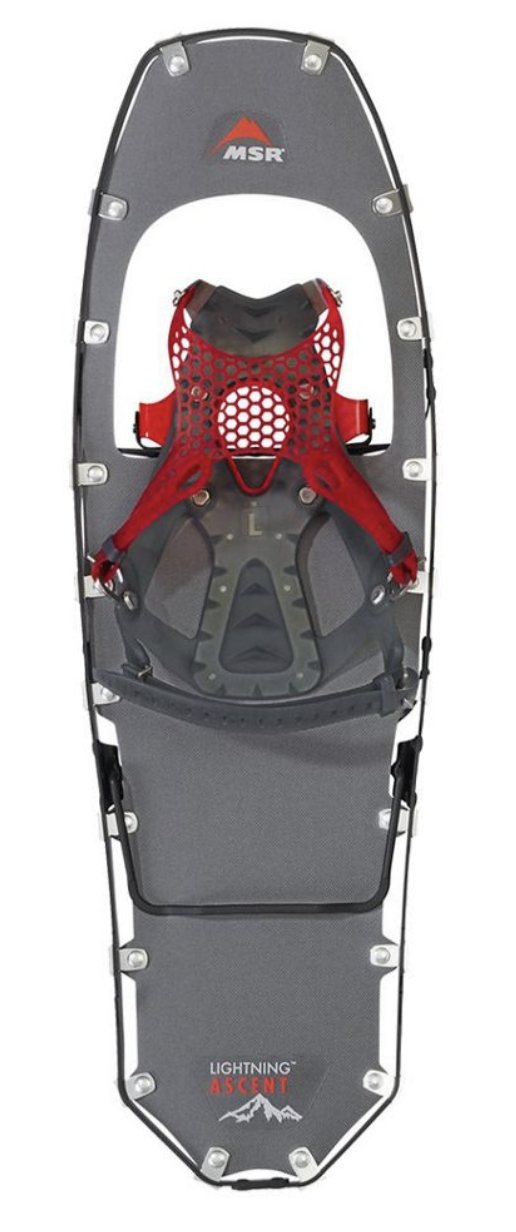 Category: Backcountry
Category: Backcountry
Lengths: 22, 25, 30 in. (5-in. tails optional)
Weight per pair: 4 lb. 5 oz. (25 in.)
What we like: Top-notch performance with best-in-class traction and comfort.
What we don’t: Expensive and overkill for easy terrain.
The Evo Trail above is fully capable for on-trail use, but it’s a little underbuilt for trudging through deep snow and navigating more aggressive slopes. If that’s your intended use, MSR’s top-end Lightning Ascent is the better match: Built on a quality aluminum frame with nylon decking, this snowshoe feels light, is nimble underfoot, and can take on anything from packed trails to powder and challenging mountain terrain. Its traction system is best-in-class with a sturdy crampon and rails running both length- and width-wise that confidently bite into anything from ice to soft snow. And with the latest update, MSR addressed our primary complaint with the old model: the binding system. With one large piece of rigid mesh covering the foot, the design is more modern without compromising foot hold or comfort (just make sure to fasten down the straps tightly so they don’t pop out in use).
The biggest downside to choosing the Lightning Ascent is its eye-wateringly steep $390 price tag. Recreational and occasional snowshoers certainly can go cheaper with models like the MSR Evo Trail above and others below, but expect sacrifices in overall performance and build quality. In terms of lengths, the Lightning Ascent is offered in 22-, 25-, and 30-inch variations. Your local snow conditions and weight will dictate which version is best (go longer for more flotation), but we prefer the shortest option. Its trimmed-down shape and reasonable weight make it well suited for everything from quick walks over rolling terrain to winter peak bagging (flip the heel bars up on extended climbs). And for deep snow, you can throw on the optional 5-inch Lightning Tails ($75) for a boost in flotation... Read in-depth review
See the MSR Lightning Ascent See the Women's MSR Lightning Ascent
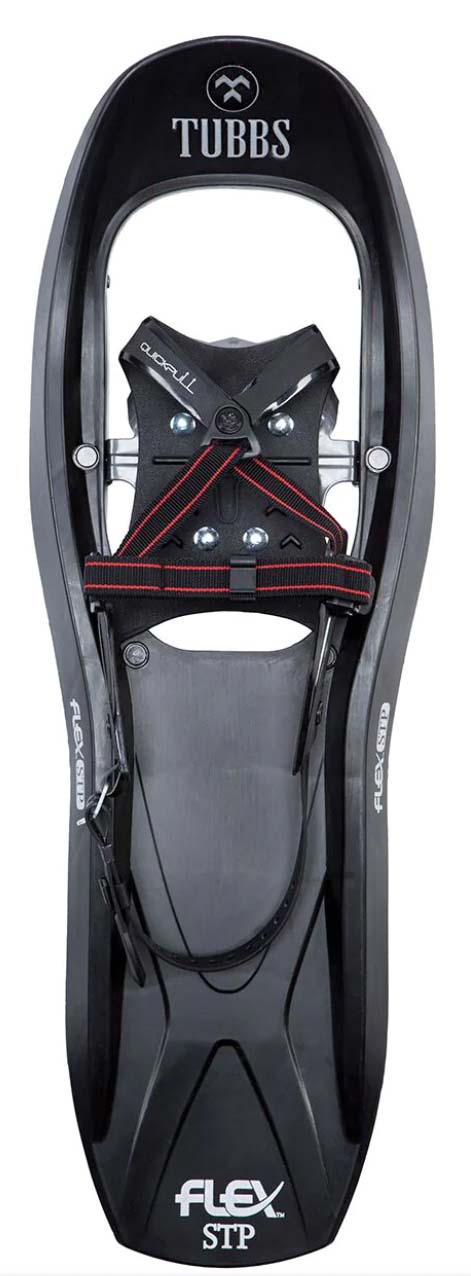 Category: Trail
Category: Trail
Lengths: 24, 28 in.
Weight per pair: 3 lb. 9.6 oz.
What we like: A fully capable trail snowshoe that won’t break the bank.
What we don’t: Basic binding design lacks the fit customization and security of pricier options.
MSR’s Evo Trail above is a great value at $170, but those new to snowshoeing can save even more cash with Tubbs' budget-friendly Flex STP. For a considerable $60 less than the Evo Trail, the Flex STP doesn’t skimp much on all-out performance: The composite Torsion Deck is more flexible and less noisy than the MSR’s plastic design without any major compromise in durability, plus you get Tubbs' Flex Tail technology for impact absorption and a rotating toe cord for shedding excess snow off the tails. The Flex STP is also offered in both 24- and 28-inch options (the Evo Trail comes in a single 22-in. length), which translates to added float in deeper snow.
What do you sacrifice by saving with the Tubbs Flex STP? Our biggest complaint has to do with the binding system: While the strap-based design is reasonably fast and easy to adjust, it lacks the customization and security of many other options here (including the Evo Trail above and Boa-equipped models below). Additionally, you forgo heel risers. If this is a dealbreaker for you, it may be worth upgrading to Tubbs’ $30-pricier Flex ESC, although they share the basic binding system outlined above. But in the end, you’d be hard-pressed to find better performance at this price point, and those just dipping their toes into snowshoeing will find a lot to like with the Flex STP.
See the Tubbs Flex STP See the Women's Tubbs Flex STP
 Category: Backcountry
Category: Backcountry
Lengths: 25, 30, 36 in.
Weight per pair: 5 lb. 4.8 oz. (30 in.)
What we like: Awesome flotation and grip.
What we don’t: A little heavy for long distances.
Of any snowshoe on this list, the Tubbs Mountaineer is perhaps the best for breaking new trails. The frame and decking are burly and wide, and if you opt for the long 36-inch model, you can make your way through some pretty deep powder. Looking underneath, it may not appear the crampons and traction are much of an upgrade from standard Tubbs models, but trust us, there’s real performance there. The deep and strong (and appropriately named) Anaconda crampons feature eight teeth under your toes and the ball of your foot. And the 36-inch version can handle up to 300 pounds (depending on snow conditions), which is top-of-the-pack in the backcountry category.
Keep in mind that the Tubbs Mountaineer is less versatile than other models on this list. Both the 30- and 36-inch models are quite hefty at over 5 pounds, which can make for some tired legs during longer treks (if weight is a significant concern, we recommend checking out the MSR Lightning Ascent above). And the large frame size and aforementioned traction system are overkill for easy winter hikes. But for those who like to venture deep into the fluffy stuff, the Tubbs Mountaineer should provide maximum flotation and is in a class of its own.
See the Tubbs Mountaineer See the Women's Tubbs Mountaineer
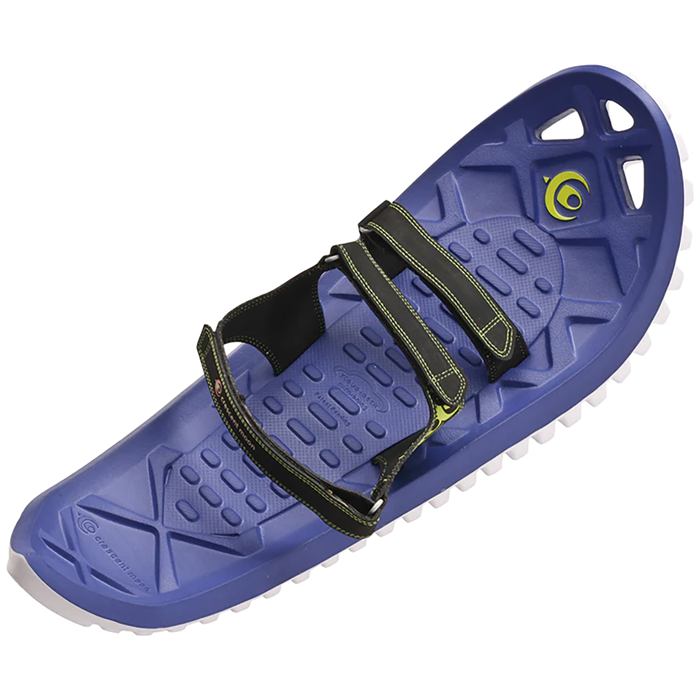 Category: Trail
Category: Trail
Length: 24 in.
Weight per pair: 3 lb. 8 oz.
What we like: Intuitive binding system and comfortable foam construction.
What we don’t: Does not excel on steep or technical terrain.
Crescent Moon’s all-foam Eva snowshoe received a lot of fanfare at its release, and for good reason. Unlike the hard plastic or aluminum-framed designs that dominate the market, the unique Eva is built with two layers of EVA foam. The top is relatively soft to provide cushioning, while the bottom is a denser and tougher variety for traction and durability. The flexible construction, Velcro binding system, and rockered shape make these snowshoes comfortable and easy to handle. With the addition of six small “Icespikes” on the bottom of each shoe, the current Eva technically adds metal to the mix, but we like the improvements and overall concept.
All thing considered, the Eva performs best on relatively flat terrain and for more casual snowshoeing adventures. The Icespikes are a positive change as the old model lacked bite, and we can’t help but appreciate the simplicity and ease of use, including the bindings. In addition, we were pleasantly surprised with the durability of the foam, which was one of our biggest initial concerns. However, the Eva isn’t as adept at tackling tough terrain or deep powder as many of the models above. Having said that, it’s a great snowshoe for easy to moderate terrain, and at a reasonable price to boot.
See the Crescent Moon Eva
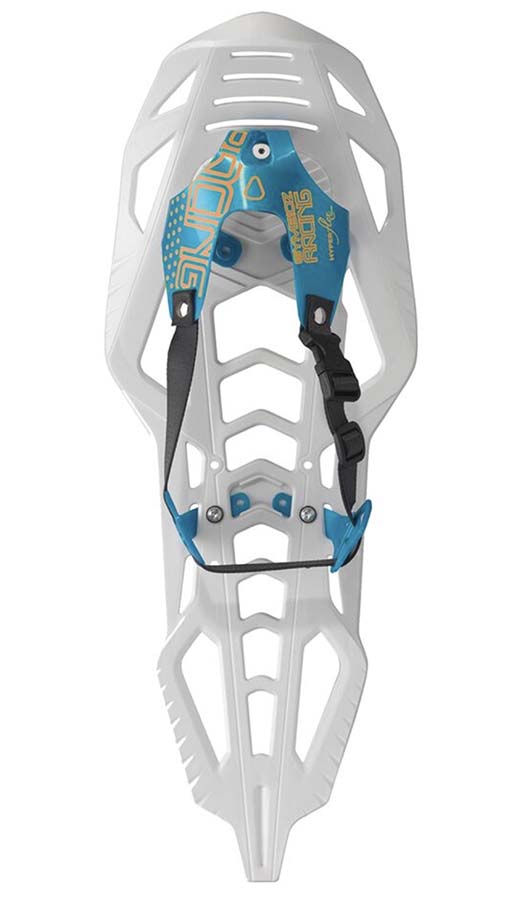 Category: Running
Category: Running
Length: 21 in.
Weight per pair: 1 lb. 7 oz.
What we like: A great design for those who like to move fast.
What we don’t: Limited versatility.
The majority of snowshoes on this list are built for everything from casual winter hiking to getting off-trail in more serious terrain, but there is another category altogether: running. When the snow starts falling, that doesn’t mean you have to give up your favorite pastime, and that’s where the TSL Symbioz Hyperflex Racing comes in. With a trimmed-down build and ultralight design (the total combined weight of both shoes is a feathery 1 lb. 7 oz.), the Hyperflex is built for moving fast. Don’t expect serious flotation here—the minimalist frame performs best over packed snow, and the narrow tails aren’t meant for powder. But for runners and racers, it’s our top pick this winter.
The market for running snowshoes isn’t huge, but Atlas and Crescent Moon offer some viable alternatives to the Symbioz Hyperflex Racing. Starting with the former, Atlas’ Run and Race models cost more ($270 and $320 respectively) but feature quieter nylon decking, upgraded binding systems, and aluminum “cleats” for reliable grip in firm conditions. Crescent Moon also offers their Luna, an all-foam running design modeled after their popular Eva above, and Yellowstone, a shorter (24.5 in.) and lighter (3 lb. 4.8 oz.) iteration of their Sawtooth 27 below. We consider the TSL to be the most well-rounded of the bunch, but a final decision will come down to preferences on weight, construction, and price.
See the TSL Symbioz Hyperflex Racing
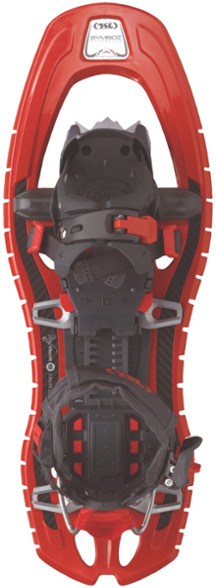 Category: Trail/backcountry
Category: Trail/backcountry
Lengths: 20.5, 23.5, 27 in.
Weight per pair: 4 lb. 5 oz. (23.5 in.)
What we like: Impressive combination of comfort, traction, and stability.
What we don’t: Narrow profile isn’t great in soft snow.
TSL’s Symbioz Hyperflex Racing above is a decidedly niche option for winter runners, but the good news is that the French brand offers plenty of more versatile designs, including the popular Symbioz Elite here. We have a season of use under our belt with the 23.5- and 27-inch models and came away very impressed with the super stable feel, reliable traction, and high level of comfort. The plastic decking flexes naturally and absorbs impact very well, but where the TSL truly shines is its unique binding system. Like an alpine touring frame binding, there is a plate under your entire foot that moves with you as you walk. The result is rock-solid support and fantastic technical abilities for steep terrain in a range of snow conditions.
What are the downsides of the Symbioz Elite? The 23.5-inch model has a narrow profile that doesn’t provide as much flotation as the Lightning Ascent above in deep snow (opting for the 27-in. version does help). Further, the binding system takes some time to set up properly—we don’t recommend doing it for the first time out in the frigid cold like we did. And because the plate has to match the length of your boot sole, it can be a pain to adjust if multiple people share the snowshoe. But these are small complaints about an otherwise outstanding design that's comfortable and performs extremely well. Other options from the collection include the less aggressive Symbioz Hyperflex Access ($230), carbon-reinforced Symbioz Hyperflex Adjust ($310), and top-end Symbioz Hyperflex Instinct ($330).
See the TSL Symbioz Elite Snowshoe
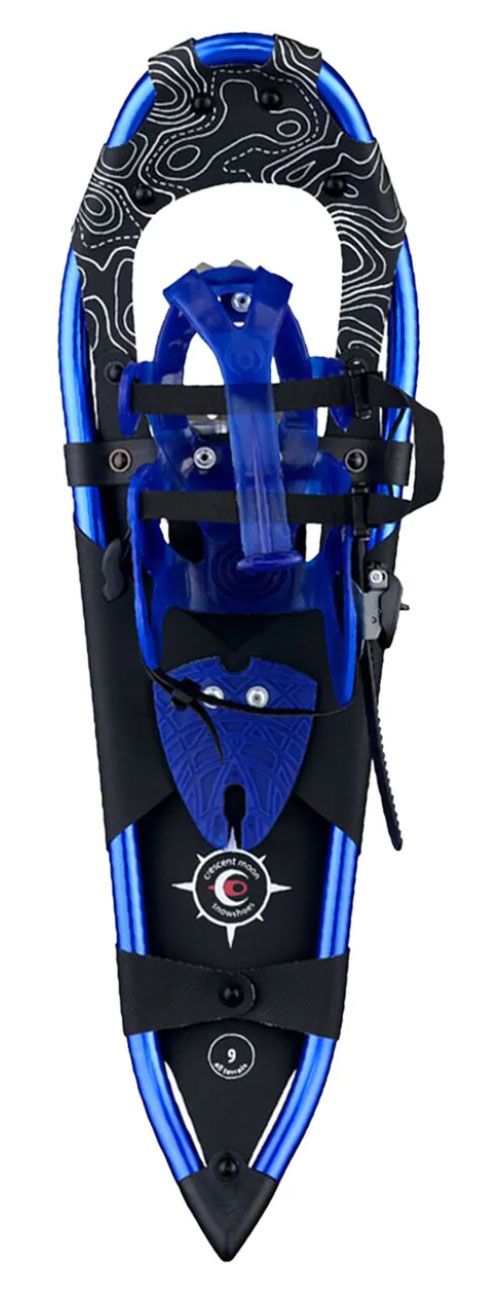 Category: Trail
Category: Trail
Length: 27 in.
Weight per pair: 4 lb. 6.4 oz.
What we like: Great price for what you get; intuitive binding system.
What we don’t: Average traction and heel lifters cost extra.
Crescent Moon operates a little differently than most outdoor gear manufacturers. This Boulder-based company specializes in snowshoes, assembles them in the U.S.A. with top-end materials, and has a standout repair and warranty policy. From their lineup, the Sawtooth 27 (formerly called the Gold 9) offers solid versatility for trail hiking: Its rockered shape and 27-inch length balance walkability with flotation in soft snow, the binding system provides a secure and comfortable hold, and the steel traction is sturdy and reliable. Tack on a fairly reasonable price of $200, and you get a very well-rounded snowshoe.
What are the limitations in the Sawtooth 27’s construction? First, its claw-like crampons grip reasonably well in soft snow and hardpack, but for steep slopes or sketchy traverses, they lack the aggressive bite that you get from MSR’s Lightning Ascent above. Second, a heel lifter for reducing calf fatigue on extended climbs is not included, although you can purchase one as an accessory directly from Crescent Moon for $15. That said, the Sawtooth’s compelling mix of price, build quality, and on- and off-trail performance earn it a high spot on our list. For a longer and more powder-ready option from Crescent Moon, check out their Big Sky 32 ($220).
See the Crescent Moon Sawtooth 27
 Category: Backcountry
Category: Backcountry
Lengths: 25, 29 in.
Weight per pair: 4 lb. 5.9 oz. (25 in.)
What we like: Nimble, pretty light, and good fit with the Boa system.
What we don’t: Expensive and shorter than their Mountaineer model above.
Boa closure systems are popular on a range of footwear categories, and they’ve more recently started hitting the snowshoe market. The allure is clear: Rather than fumbling with a host of adjustment points that can come undone on the trail, the one-dial cable system tightens the entire binding with a few simple turns. Accordingly, the Tubbs Flex VRT is one of the easiest snowshoes on this list to put on (at least for us) and therefore a top pick for those who love simplicity. It’s also very comfortable and cinches evenly around the foot without creating any pressure points.
It's worth noting that the past-generation Flex VRT was only offered in a single 24-inch length, while the latest model comes in longer 25- and 29-inch variations for a boost in flotation. It still falls short of Tubbs’ own 30- or 36-inch Mountaineer above for truly deep days, but the Flex VRT is lighter (by around 6-8 oz. per pair depending on length) with a very nimble and agile feel to match. Price will be the biggest deterrent for many, and recreational users sticking to easier terrain can save considerably with Tubbs' own Flex RDG (which, at $200, also has a Boa dial). But that snowshoe is smaller at 24 inches long and uses downgraded traction, giving the VRT the clear edge for performance use in deeper snow.
See the Tubbs Flex VRT See the Women's Tubbs Flex VRT
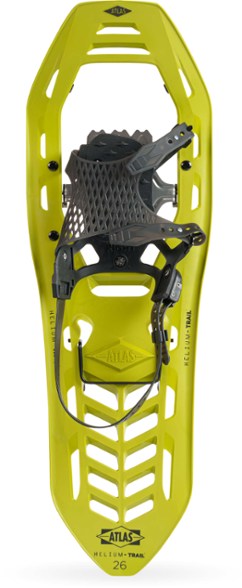 Category: Trail
Category: Trail
Lengths: 23, 26, 30 in.
Weight per pair: 3 lb. 7 oz. (26 in.)
What we like: Lighter and more length options than the MSR Evo Trail above.
What we don’t: We still have concerns about flotation in soft snow.
For years, MSR has dominated the simple plastic decking concept with its uber-popular Evo and Revo lines, which simplify the design and keeps cost low. More recently, however, Atlas came up with a direct competitor in their Helium Trail. Interestingly, Atlas added a healthy number of “gills” in the frame, which means less material overall and a sizable drop in weight (the 23-in. Helium Trail is 8 oz. lighter per pair than the 22-in. Evo Trail). You also get a steel crampon for grip, three length options to choose from (the MSR only comes in one), and even a heel lift for big ascents, which the MSR lacks. For the same price, the Helium Trail is a very strong alternative with some thoughtful upgrades.
Atlas updated the Helium Trail last season, with the biggest change being a new Wrapp Stretch binding. On first glance, the design is very similar to MSR’s Paraglide outlined above: Both are flexible, easy to adjust, and do a good job locking the foot in place. We haven’t had a chance to test the latest Helium Trail yet, but it’s safe to assume that it’s a major upgrade over the past version’s webbing strap, which came dangerously close to the rail teeth and was prone to tearing while hiking. Atlas also added a longer 30-inch version to the collection, although the unique design still leaves us with some concerns about flotation in soft snow—it seems decently likely that snow could penetrate upward and make movement more difficult. That said, the Helium Trail hits most of the features we look for in a recreational snowshoe, including a quality build, easy-to-use design, and good price point. For $30 more, Atlas’ Access comes with a lot of the same features, plus quieter nylon decking and taller heel lift.
See the Atlas Helium Trail
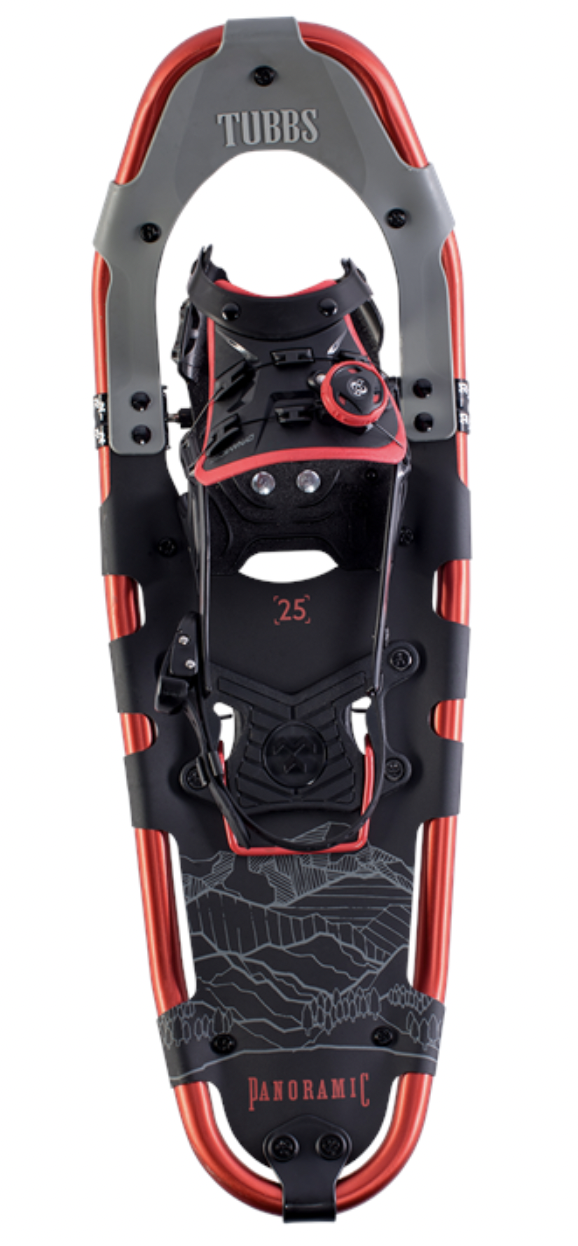 Category: Trail/backcountry
Category: Trail/backcountry
Lengths: 25, 30, 36 in.
Weight per pair: 4 lb. 8 oz. (30 in.)
What we like: A capable, user-friendly option for a wide variety of conditions.
What we don’t: Expensive and a little underbuilt for truly challenging terrain.
Sitting at the top of Tubbs’ day hiking category is their Panoramic, which ticks most of the boxes we look for in an all-rounder snowshoe. The simple nylon decking is quieter and softer on snow than plastic, and you get a healthy set of functional features including steel toe crampons and side rails for grip and a heel lift for extended climbs. Additionally, Tubbs put a big focus on comfort by incorporating an upturned tail and shock-absorbing tech that are designed to promote a more natural gait and better cushion your ride. Like Tubbs’ Flex VRT above, the Panoramic also sports a Boa system that makes it quick and easy to dial in fit. And with a nice selection of lengths ranging from 25 to 36 inches, it’s a quality shoe for both on- and off-trail use.
All that said, the Panoramic falls into a bit of an awkward in-between spot: too aggressive for mellow outings but a little underbuilt for big backcountry missions. The simple frame rails are noticeably small and shallow compared to options like MSR’s Lightning Ascent and Tubbs’ own Mountaineer above (the latter of which costs only $10 more), making it less appealing for truly challenging days or icy and steep ascents. Alternatively, Tubbs’ $70-cheaper Wayfinder also includes a Boa system and nylon decking but forgoes a heel lift and has less aggressive traction, while Atlas’ $250 Montane offers similar versatility but without the Boa dial. Whether or not the Panoramic’s upgrades are worth the jump in price is up to you, but true backcountry enthusiasts will likely want to step up to a more performance-focused option.
See the Tubbs Panoramic See the Women's Tubbs Panoramic
 Category: Trail/backcountry
Category: Trail/backcountry
Lengths: 26, 30 in.
Weight per pair: 3 lb. 13.4 oz. (26 in.)
What we like: A legitimate competitor to the MSR Lightning Ascent for $160 less.
What we don’t: Falls a little short in soft-snow performance and traction.
MSR’s Lightning Ascent is widely considered to be the best all-around snowshoe on the market (hence our ranking), but snowshoe giant Atlas recently released a very promising alternative in their Range-Trail. The Wrapp Stretch binding looks a lot like MSR’s well-loved Paragon system, with a flexible design that’s easy to get on and off and provides a secure and comfortable fit around the foot. The rest of the features are well sorted and what we would expect at this price range, including a durable aluminum frame, sturdy crampon rails (including one at the front of the foot for steep slopes), 19-degree heel lift, and flexible nylon decking that gives the snowshoe a light and responsive feel underfoot.
In deciding between the Lightning Ascent and Atlas Range-Trail, there are a couple differences to be aware of. While the Atlas will save you a whopping $160 and 7.6 ounces in weight per pair (compared to the 25-in. Lightning Ascent), it’s only offered in two sizes (the MSR is available in three) and has a slightly narrower platform (7.5 in. vs. 8) that won’t provide as much float in soft snow. The Atlas also falls a little short in the traction department with rails that only run lengthwise (the MSR has an additional rail that runs widthwise under the foot). Combined with the Lightning Ascent’s impressive track record, we hesitate to rank the Range-Trail higher just yet. But all signs are positive that it will be a quality competitor, and we’ll update this write-up once we’ve logged some milage with the design. Of note: Atlas also offers the Range in a more backcountry-ready BC model and Boa-equipped MTN variation, although the Trail listed here is the only one with the Wrapp Stretch binding.
See the Atlas Range-Trail See the Women's Atlas Range-Trail
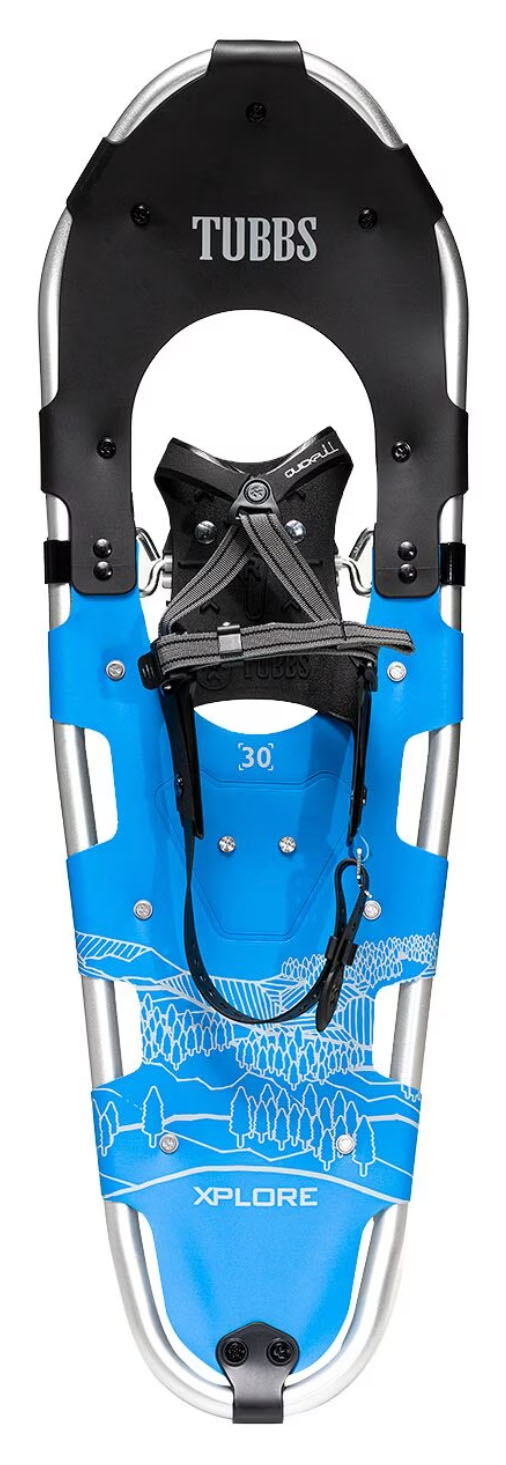 Category: Trail
Category: Trail
Lengths: 25, 30 in.
Weight per pair: 3 lb. 8 oz.
What we like: A solid value for new or occasional snowshoers.
What we don’t: Subpar traction and no heel lift.
Snowshoes are an increasingly expensive bunch, which is one of the biggest reasons we love Tubbs’ Xplore. For a very reasonable $150, the Xplore boasts many features often found in pricier models, including a reliable aluminum frame, quality nylon decking, an intuitive and secure binding system, and a rotating toe cord for shedding excess snow (shared with their Flex STP above). You also get two length options to choose from—25 or 30 inches—which should keep you afloat in most snow conditions from hardpack to a few inches of fresh powder. Taken together, the Xplore is a great value and plenty of snowshoe for new and occasional users alike.
Where does the Tubbs Xplore fall short of the competition? The most obvious concession is traction: The heel and toe crampons are noticeably shallow and lacking in grip compared to designs like the $20-pricier Evo Trail above, and you don’t get side rails for lateral stability. The Xplore also forgoes heel lifters, which won’t be a dealbreaker if you stick to mellow terrain but can make the uphills a whole lot easier. For the same price, Atlas’ Helium Trail above includes both a heel lift and side rails for better all-around grip, plus a more secure binding system that covers the entire foot. But the Tubbs is the more traditional—and arguably more approachable—option for newcomers with its standard nylon decking (the Atlas’ gills are a little polarizing), which may be the deciding factor for some. For $30 more, we also like Tubbs’ Frontier, which boasts upgraded traction and comes in a longer 36-inch version for navigating deeper snow.
See the Tubbs Xplore See the Women's Tubbs Xplore
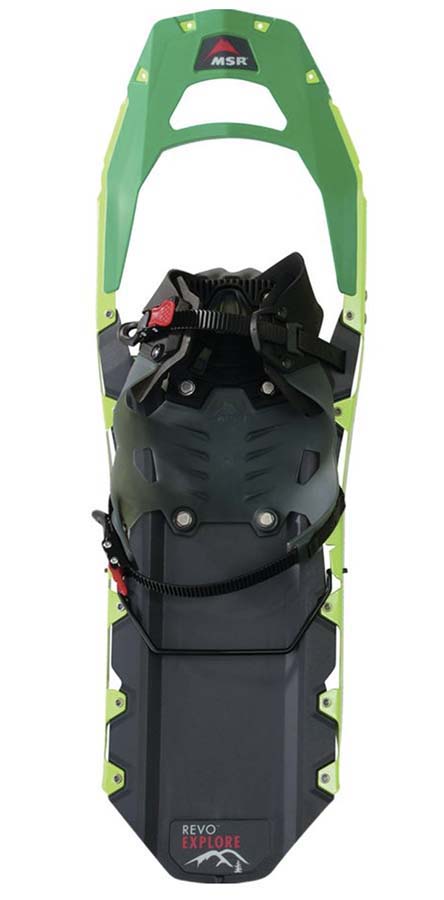 Category: Trail
Category: Trail
Lengths: 22, 25 in.
Weight per pair: 4 lb. 3 oz. (25 in.)
What we like: Traction from the Lightning Ascent with a tough plastic build.
What we don’t: There are more comfortable options for the price.
MSR’s snowshoe lineup is extensive to say the least, and we’ve already featured their best-selling Lighting Ascent and Evo Trail above. But the Revo Explore is a nice hybrid concept that combines the traction of the high-end Lightning with the price-conscious plastic decking of the Evo. In practice, the Revo does a fairly good job mixing those two snowshoes’ strongest attributes—most notably, the rugged side rails provide more grip than any model in this price range. The result is a snowshoe that is more capable on rolling and challenging terrain but costs a significant $120 less than the high-end Lightning Ascent.
However, we think there are more well-rounded mid-range options than the MSR Revo Explore. The Tubbs Panoramic above, for example, costs the same but comes with worthwhile upgrades like flexible decking with superior shock absorption and a more comfortable binding. And it’s worth noting that stepping up to the Trail or Ascent versions of the Revo will get you MSR’s improved Paraglide and Paragon bindings (respectively) that are more comfortable for long days on the trail. All in all, we like the Revo Explore, but this portion of the market is crowded, and it’s less of a standout than MSR’s other models.
See the MSR Revo Explore See the Women's MSR Revo Explore
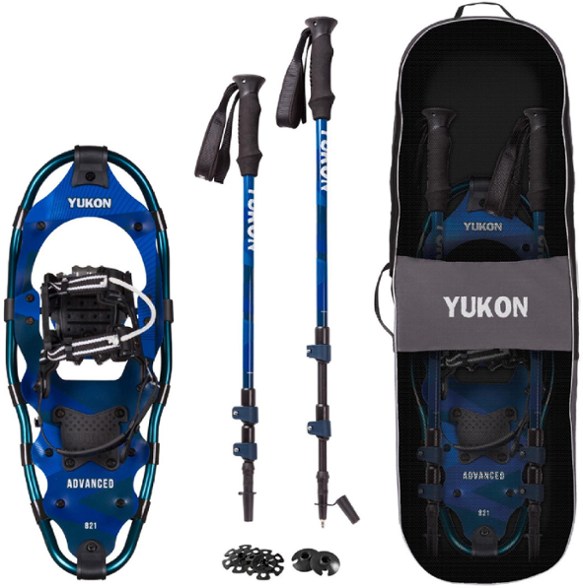 Category: Trail
Category: Trail
Lengths: 21, 25, 30, 36 in.
Weight per pair: 4 lb. 3.2 oz. (25 in.)
What we like: All-in-one kit makes it easy for beginners to hit the trail.
What we don’t: Limited traction and not made for steep terrain.
Many of the brands above offer prepacked snowshoe kits for those just getting started, and Yukon Charlie’s Advanced Snowshoes Kit is one of the most popular. The biggest advantages here are value and convenience: While the Advanced snowshoes on their own start at $140 per pair, the kit tacks on adjustable poles and a handy carrying bag for just $50-$60 more depending on length (note: The kit is available for even less on Amazon at the time of publishing, which is reflected in the price we listed above). For reference, buying those items separately will almost certainly cost more, and the poles include both powder and trekking baskets for year-round versatility. And the snowshoes themselves are great for most casual users, including a simple single-pull binding system, lightweight and reliable aluminum frame, and sufficient comfort for short winter walks.
To be clear, the Advanced is a perfectly viable starter kit for those just getting into the sport but won’t hold up to aggressive or extended backcountry use. The basic binding system isn’t all that secure and will need readjustment over longer stretches, you don't get a heel lift for steep inclines, and grip is decidedly limited with just one crampon under the forefoot (there are no frame rails). But these are fine tradeoffs for recreational hikers who stick to flat ground near the cabin or established trails. And there’s certainly something to be said about the convenience of buying everything at once—especially when you factor in the price, which undercuts MSR’s popular Evo Trail Snowshoe Kit by well over $100.
See the Yukon Charlie's Advanced Snowshoes Kit
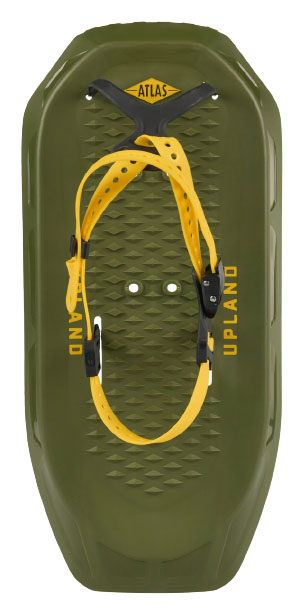 Category: Backcountry
Category: Backcountry
Length: 19 in.
What we like: A relatively cheap way for snowboarders to dip their toes into backcountry riding.
What we don’t: Decidedly limited in all-around appeal.
Rounding out our list for this season is a new and unique addition to the snowshoe market: Atlas’ Upland. Purpose-built for backcountry snowboarders, the Upland boasts a lightweight frame and composite decking in a short, 19-inch package. On the way up, the wide but streamlined platform and slightly rockered tail strike a nice balance between maneuverability and float, while the bottom features “rails” that are built into the frame and run almost the entire perimeter. Further, the binding system is specifically designed to accommodate snowboard boots with a crampon-style strap over the forefoot and a quick-release buckle for fast adjustments. And on the descent, the compact and minimalist design is supremely easy to secure to the outside of a pack.
It's worth noting that Atlas’ new Upland isn’t the only option on the market for backcountry snowboarders. Another innovative design is Drift’s namesake Drift Board—available in both fiberglass and carbon variations—which boasts a longer platform for plowing through deeper snow, features ski touring-inspired bindings, and comes with permanently attached climbing skins for gliding (rather than trudging) your way up. However, that design is considerably pricier at around $450-$550 with bindings included—for that price, you can likely score a used splitboard, which will eliminate the need to carry extra weight on your back on the descent. In the end, the Upland is decidedly basic compared to Drift’s offerings, but it’s also a fraction of the cost and a nice way for snowboarders to dip their toes into backcountry riding without overhauling their entire setup.
See the Atlas Upland
| Snowshoe | Price | Category | Length(s) | Weight (per pair) |
Decking | Crampon | Heel Lift |
|---|---|---|---|---|---|---|---|
| MSR Evo Trail | $170 | Trail | 22 in. | 3 lb. 10 oz. | Plastic | Steel | No |
| MSR Lightning Ascent | $390 | Backcountry | 22, 25, 30 in. | 4 lb. 5 oz. | Nylon | Steel | Yes |
| Tubbs Flex STP | $110 | Trail | 24, 28 in. | 3 lb. 9.6 oz. | Composite | Steel | No |
| Tubbs Mountaineer | $280 | Backcountry | 25, 30, 36 in. | 5 lb. 4.8 oz. | Nylon | Steel | Yes |
| Crescent Moon Eva | $170 | Trail | 24 in. | 3 lb. 8 oz. | Foam | Steel spikes | No |
| TSL Hyperflex Racing | $200 | Running | 21 in. | 1 lb. 7 oz. | Plastic | Steel spikes | No |
| TSL Symbioz Elite | $290 | Trail/backcountry | 20.5, 23.5, 27 in. | 4 lb. 5 oz. | Composite | Steel | Yes |
| Crescent Moon Sawtooth | $200 | Trail | 27 in. | 4 lb. 6.4 oz. | Nylon | Steel | No |
| Tubbs Flex VRT | $280 | Backcountry | 25, 29 in. | 4 lb. 5.9 oz. | Composite | Steel | Yes |
| Atlas Helium Trail | $150 | Trail | 23, 26, 30 in. | 3 lb. 7 oz. | Composite | Steel | Yes |
| Tubbs Panoramic | $270 | Trail/backcountry | 25, 30, 36 in. | 4 lb. 8 oz. | Nylon | Steel | Yes |
| Atlas Range-Trail | $230 | Trail/backcountry | 26, 30 in. | 3 lb. 13 oz. | Nylon | Steel | Yes |
| Tubbs Xplore | $150 | Trail | 25, 30 in. | 3 lb. 8 oz. | Nylon | Steel | No |
| MSR Revo Explore | $270 | Trail | 22, 25 in. | 4 lb. 3 oz. | Plastic | Steel | Yes |
| Yukon Charlie's Kit | $144 | Trail | 21, 25, 30, 36 in. | 4 lb. 3.2 oz. | HDPE | Steel | No |
| Atlas Upland | $150 | Backcountry | 19 in. | Unavail. | Composite | None | No |
Trail
Trail/recreational snowshoes are great for moderate hiking trails that fall somewhere between groomed hardpack and knee-deep powder. In short, they are built for flat terrain or rolling hills but not for steep mountain ascents or heading into the less predictable backcountry. In terms of build, these snowshoes are shorter in length than backcountry models because you require less flotation (especially on maintained paths). Additionally, their traction designs are simpler and less aggressive. Some have heel lifts as this has become a popular feature, but we don't find it necessary for most moderate terrain (heel lifts are useful for extended climbs). Popular snowshoe designs in the trail category include the MSR Evo Trail, Crescent Moon Eva, and Atlas Helium Trail.
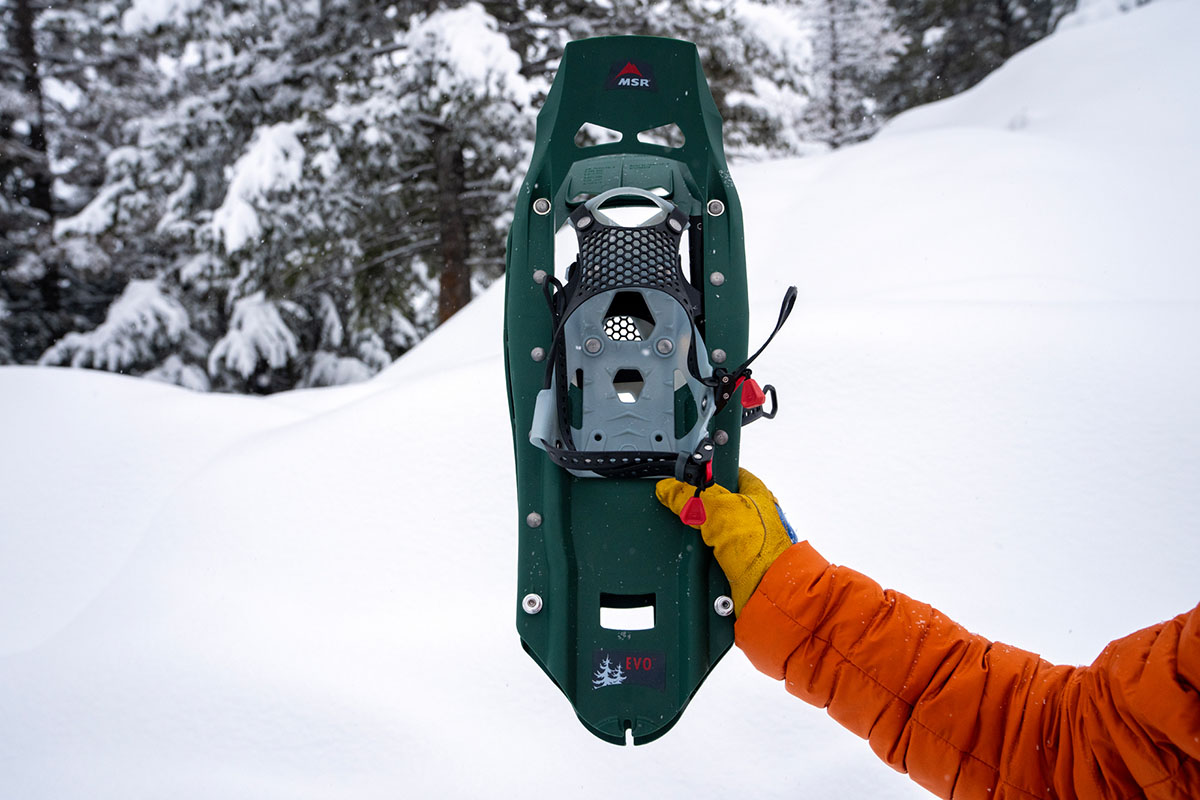
Backcountry
Backcountry snowshoes are more performance-oriented than the trail category above and ideal for those heading out into powder, tackling challenging terrain, and spending longer days out. First, they are longer in length for more float in deep snow and have increased traction to handle a variety of conditions including steep terrain and ice. Backcountry snowshoes also are the most expensive of the bunch due to the burlier builds and more complete feature sets. Keep in mind that a true backcountry model like the Tubbs Mountaineer will be overkill for casual winter snowshoeing, but many of our picks are hybrids that can work well for both uses (and you can hone this in even further based on the length you choose). Leading models in this category include the aforementioned Mountaineer and MSR Lightning Ascent (in longer sizes).
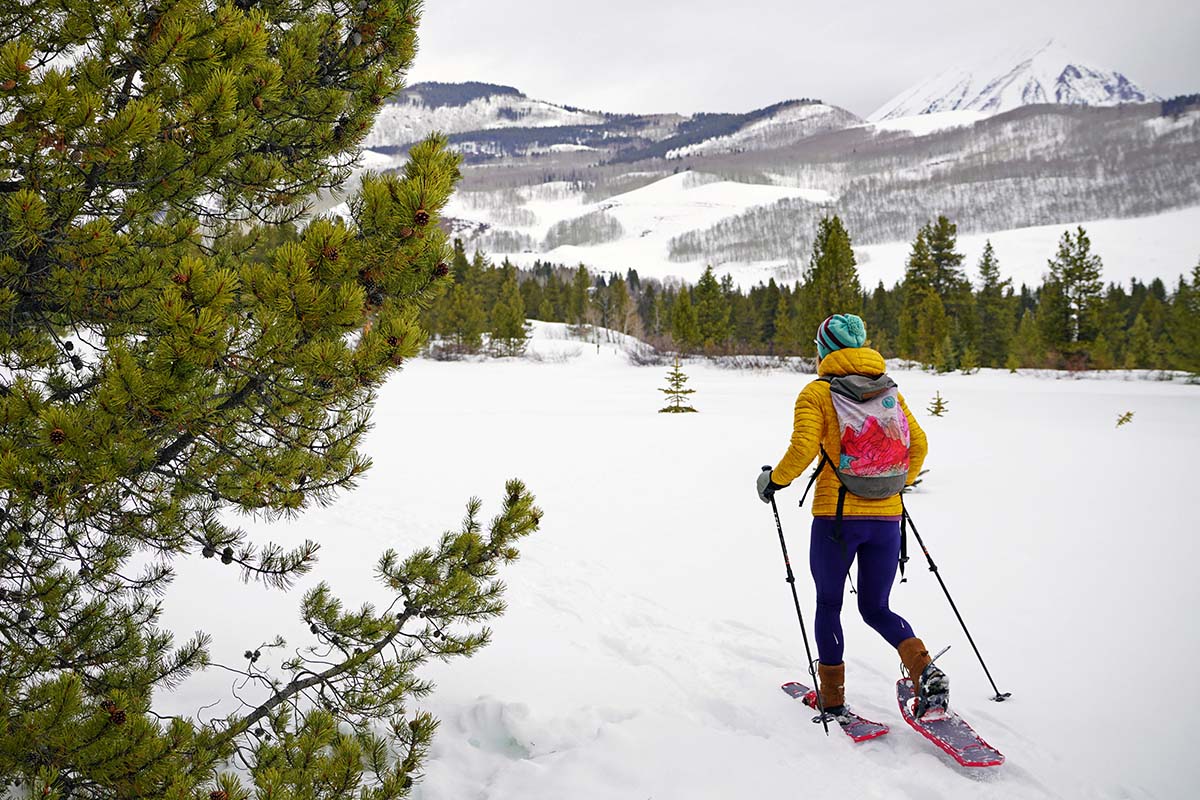
Running
A small but notable snowshoe subcategory is those built for running, also known as racing snowshoes. A lot of people don’t want to quit their favorite pastime when the snow starts to fall, and regular winter traction devices can fall short. In terms of build, running snowshoes place a premium on lightweight materials, often have a trimmed-down frame that favors speed over floatation (it’s tough to run through powder so most are tuned for hardpack or small amounts of fresh snow), upturned noses, and special traction designed to keep you moving. Popular models in this category include the TSL Symbioz Hyperflex Racing, Atlas Run, and Crescent Moon Luna.
Kids
Last but not least, a family winter adventure requires snowshoes for all parties including the kiddos. As expected, these models essentially are smaller versions of their adult counterparts and have similar designs overall, but with shorter lengths and smaller load limits. Depending on the size of your child, we like the Atlas Spark (80 to 120 lb.) and Mini (50 to 80 lb.), and MSR makes its own line of youth shoes in the Shift and Tyker. The bad news is the kids eventually will outgrow them and require an adult pair, but if chosen correctly, you should get many winters of use before that happens.
Once you get an idea of the snowshoe category you want, it's time to nail down the ideal length. This measurement is key to balance walking comfort with enough flotation to avoid sinking too deeply into the snow with each step (known as “postholing”). Most snowshoes above range from 22 inches at the short end (MSR's Lightning Ascent and Evo Trail) up to 36 inches at the long end (the Tubbs Mountaineer and Panoramic). As a general rule, shorter snowshoes are best for on-trail use and longer models are ideal for deep snow and the backcountry. In addition, the type of snow matters a great deal—in the United States, the crusty hardpack you’ll find in the East contrasts sharply with deep powder in the West. Longer snowshoes provide better flotation in soft snow, so if you’re planning on getting off-trail in Colorado or Utah, a longer snowshoe is better. If you’ll be primarily on hardpack, less flotation is required and you can go shorter.
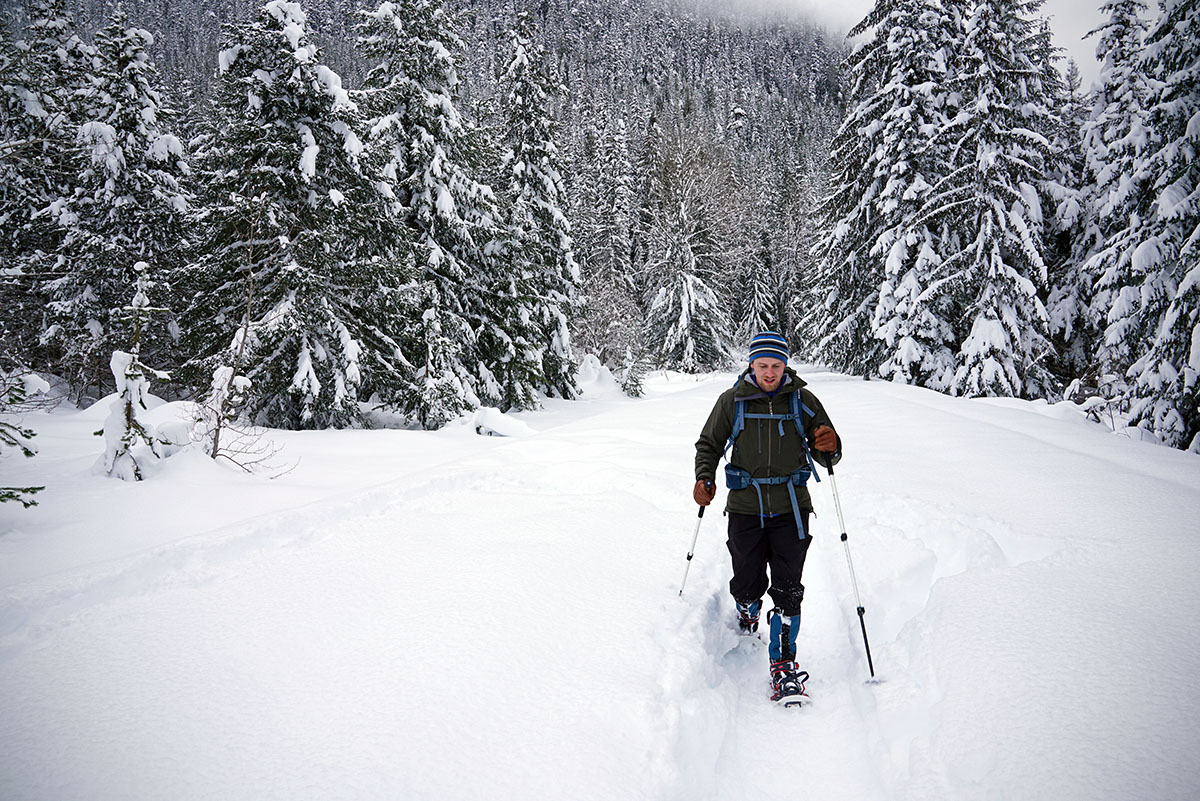
Along with snow type and terrain, your weight also plays an important role in the length of snowshoe you choose. Snowshoe manufacturers often list a recommended weight range (or "recommended load") for each shoe, which includes your body weight plus anything you’ll be carrying, such as clothing and a daypack. Heavier loads need longer snowshoes to stay afloat, so try to pick a length that best hits your weight with gear. For example, Atlas’ Range-Trail is rated to 200 pounds for the 26-inch length, 250 pounds for the 30-inch variation, and 300+ pounds for the largest 35-inch model. Finally, it's worth noting that some snowshoes have optional tails to add length depending on the user and conditions (including MSR's popular Lightning, Revo, and Evo lines).
The binding system is your link to trail comfort and also plays a significant role in stability. A good binding should comfortably hold your feet for hours on the trail without requiring constant readjustments. Interestingly, the various systems are one of the few places where manufacturers differentiate significantly from one another. One commonality you will find is that no matter the brand, comfort and adjustability improve as the price goes up.
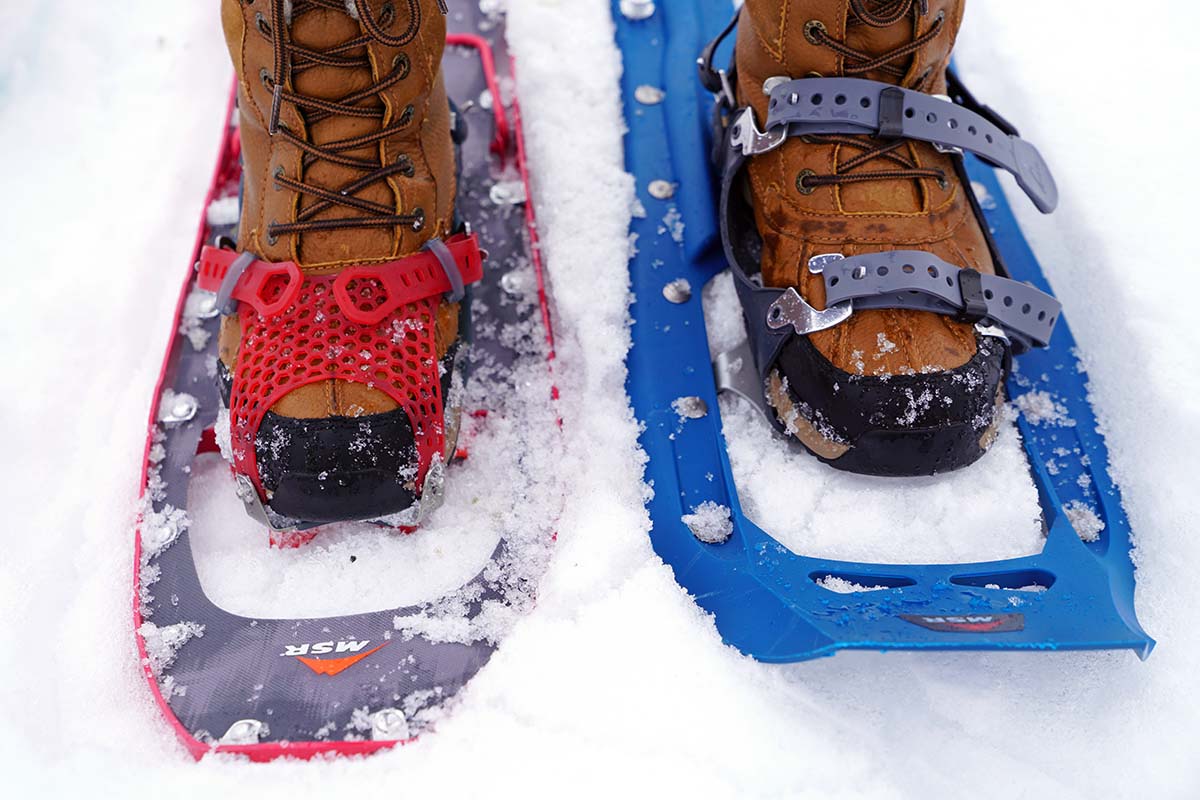
Multiple Straps or Single-Pull
The most common binding styles are either a plastic wraparound binding that is secured by a series of crisscrossing webbing, or individual straps that are secured over the foot and around the heel. Atlas and Tubbs utilize the more traditional binding and webbing design for their core models, while MSR has primarily stuck with the strap systems. Crescent Moon has a binding system that shares characteristics of both, but its single pull loop system falls more into the traditional binding category.
What’s revealing in breaking down the systems is that, despite the vital importance of a comfortable design, the binding isn’t always directly correlated with overall snowshoe quality. MSR makes absolutely bomber snowshoes, but the bindings on their entry-level Explore models fall short. Part of the reason is their commitment to a strap cinch system. The logic behind the design is that the bindings can lay completely flat to easily haul along in a pack, but the result is average in comfort and holding power. Stepping up to their Trail and Ascent collections will get you upgraded Paraglide and Paragon bindings (respectively), which offer a sizable boost in all-day comfort and security–albeit at a steeper cost.
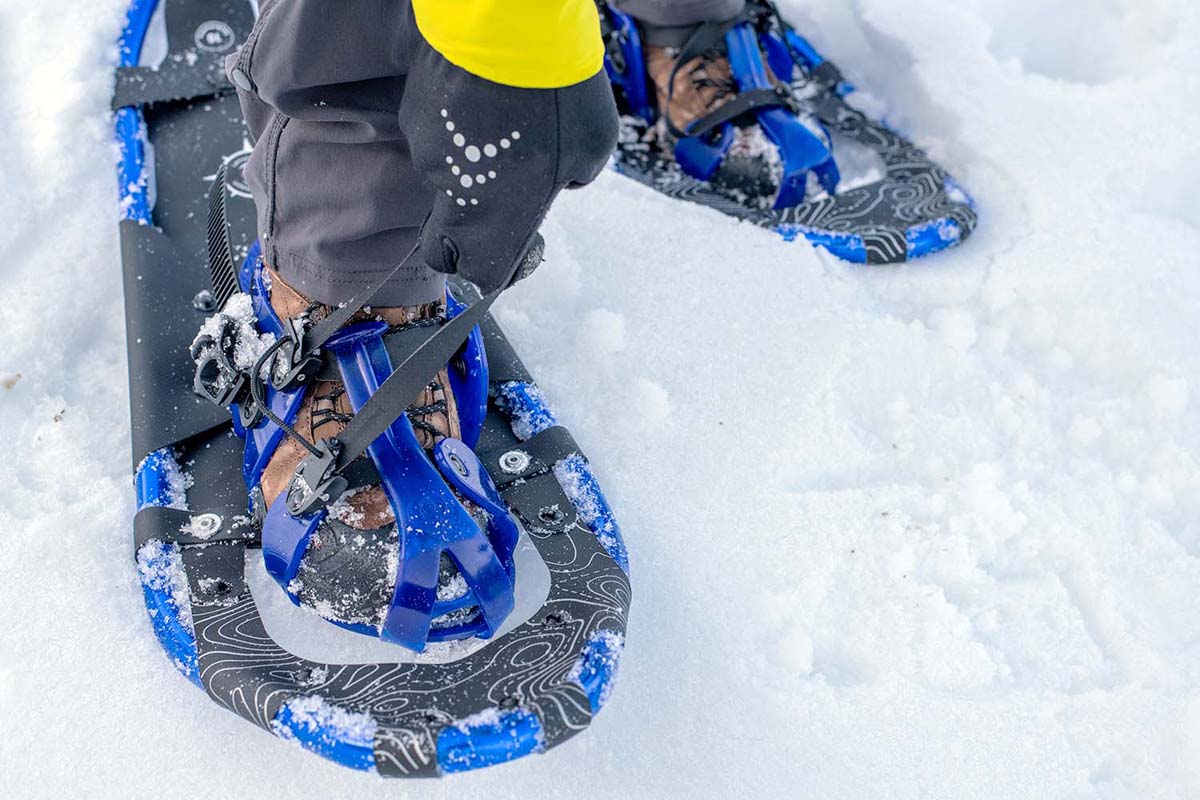
Boa
A third binding design gaining some serious traction is Boa. This system utilizes a pretty traditional wrapped binding, but the standard webbing is replaced with wiring that is tightened with the turn of a dial (the entire system cinches down on you simultaneously for impressive evenness and comfort). The technology was made popular by snowboard boots, but nowadays you’ll find it on a growing number of models of snowshoes from Atlas, Tubbs, and more. Getting a snowshoe like the Tubbs Panoramic on and off is incredibly easy and quick, particularly when compared with the three- or four-strap systems you’ll find with MSR. The main limitation is that with a single adjuster (and occasionally two), you can’t fine-tune the fit should you need to cinch down in one place and loosen another. For most folks, however, that’s a non-issue.
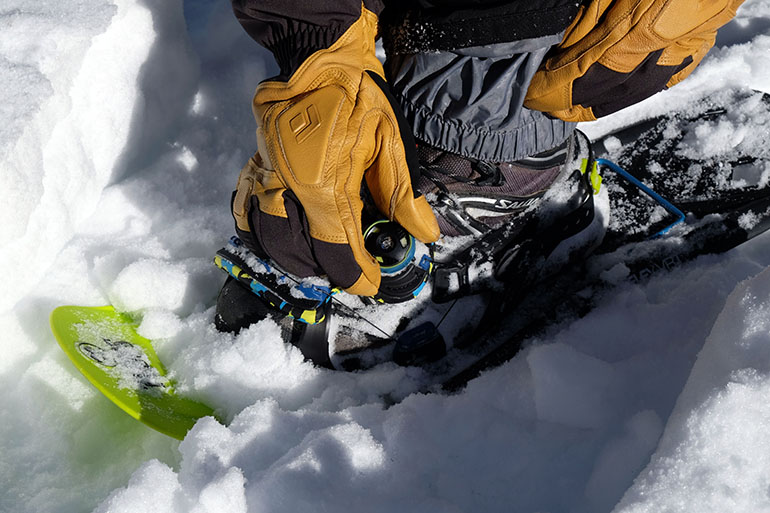
Needless to say, it’s important to check the bottom of the snowshoes you’re considering to make sure they’ve got real traction. The amount of grip and quality of the crampons and side rails can vary a surprising amount by model and price. Low cost models commonly have a small steel crampon under your toes, additional cleats around the middle of your foot, and that’s about it. On the other hand, ultralight models like the Crescent Moon Eva and TSL Symbioz Hyperflex Racing will have lightweight steel spikes rather than crampons. While reasonable for casual walking on flat ground, these designs can be overmatched on hills or snowy conditions.
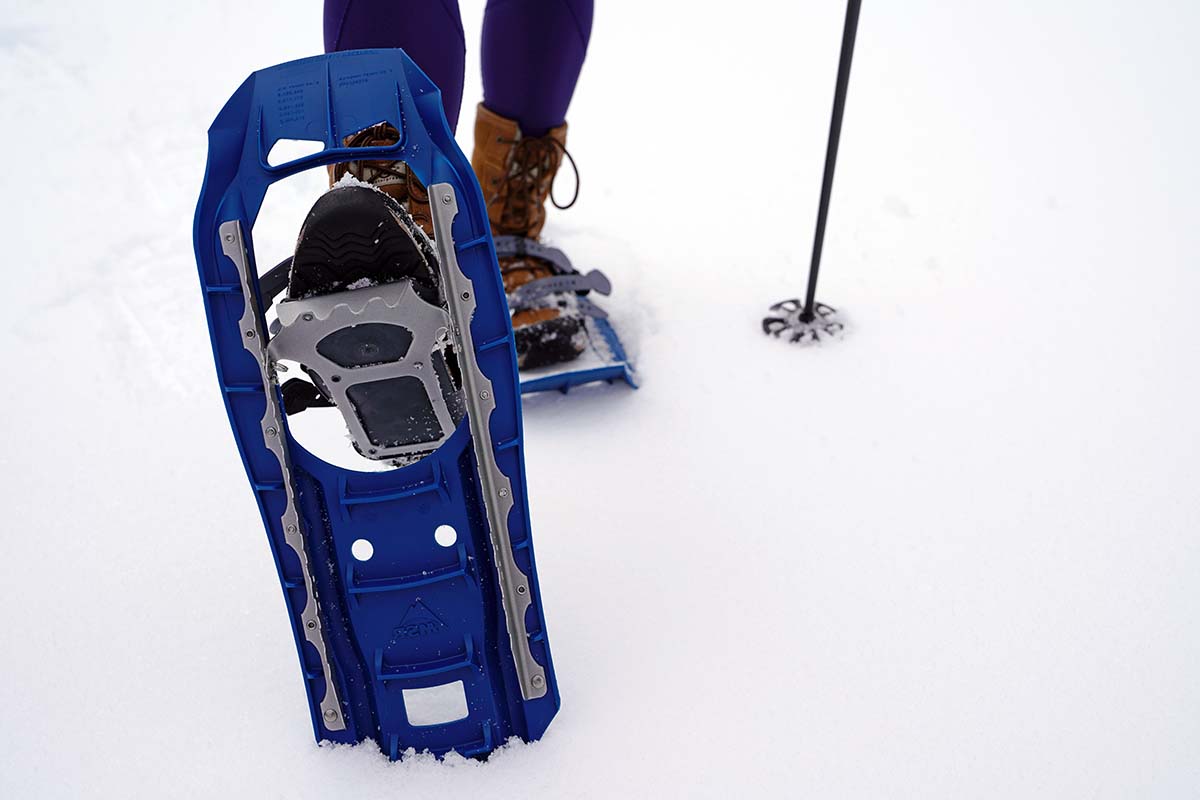
In addition to crampons, most backcountry snowshoes (and some trail models) will feature frame rails for added traction on a variety of terrain. Frame rails run length-wise along the sides of snowshoes and are a source of excellent lateral stability should you find yourself traversing a slope. They’re also helpful when maximum traction is needed on an ascent or descent, biting in for that extra level of grip. You’ll most often find frame rails on backcountry snowshoes like the MSR Lightning Ascent, but folks that hike on icy trails will appreciate them as well.
Keep an eye on the material and depth of your snowshoe traction. Occasionally manufacturers will look to save some money and use lower grade aluminum teeth that aren't quite as burly or tough over the long haul. Stainless steel bindings are found on most shoes, and the deeper and more aggressive the teeth, the better the grip.
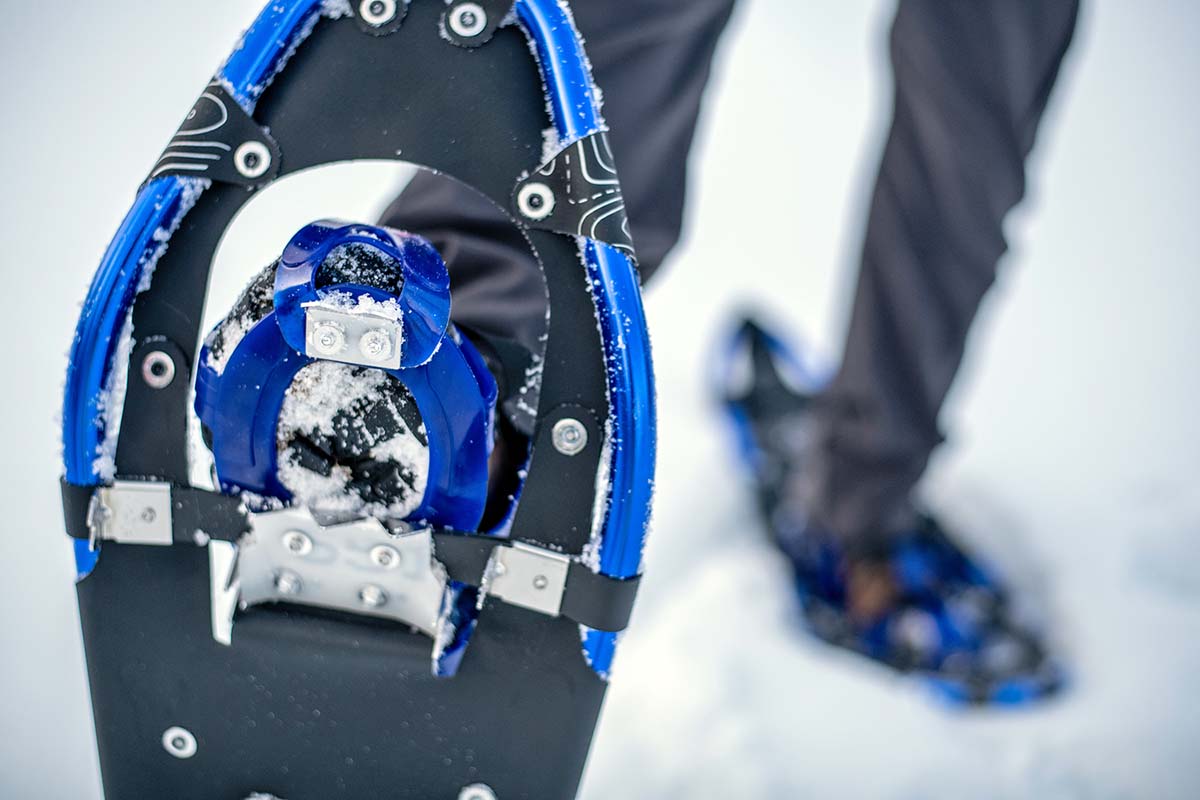
There are two general types of snowshoe: an aluminum outer frame with flexible nylon decking, and a frameless solid deck made of plastic or composite. Recently, hybrid models have popped up that use a partial aluminum frame toward the front of the snowshoe with a plastic tail.
Aluminum
Traditional aluminum-framed snowshoes are what most people are familiar with, seen in a variety of models above including the Crescent Moon Sawtooth 27, Tubbs Panoramic, and more modern-looking MSR Lightning Ascent. This is a very functional design, with a strong frame protecting you from trail hazards and a pliant but tough nylon deck that makes covering long distances comfortable. The disadvantage is traction. Although some high-end models do a great job of incorporating as much traction as possible, they still fall short compared to plastic, particularly relative to their weight (MSR's Lightning is one exception). Moreover, the decking materials are more vulnerable to tears and the occasional rivet can come out of the nylon decking. But these malfunctions are rarities from the quality brands we’ve listed in our picks above, and plastic can break too.
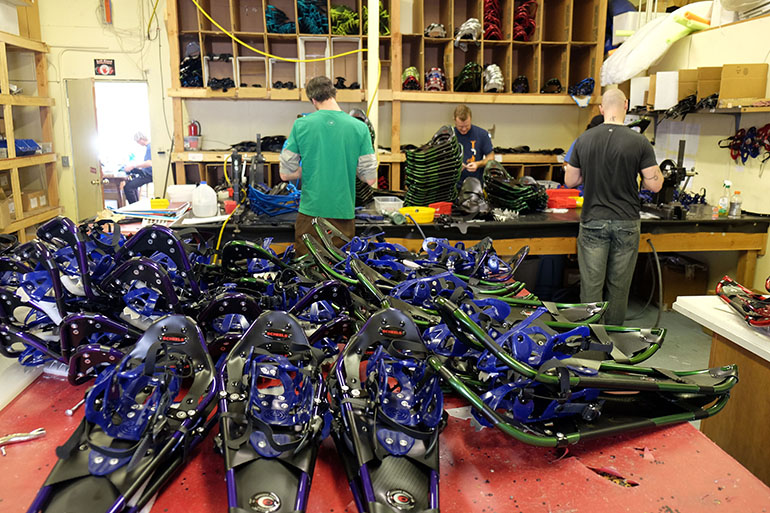
Plastic or Composite
The principle advantage of plastic or composite decking is cost—strong aluminum isn’t cheap—along with the ability to more easily incorporate traction along the sides. The downsides of plastic are that it can break—we’ve had an unfortunate front lip of an MSR Evo Trail get torn off when stepped on—and they’re noisy over crusty snow. Much more than with a traditional snowshoe, plastic has a harsher and louder heel impact when your foot comes down on hard pack. To summarize, plastic is cheaper and easier to attach traction to, but louder and slightly easier to damage.
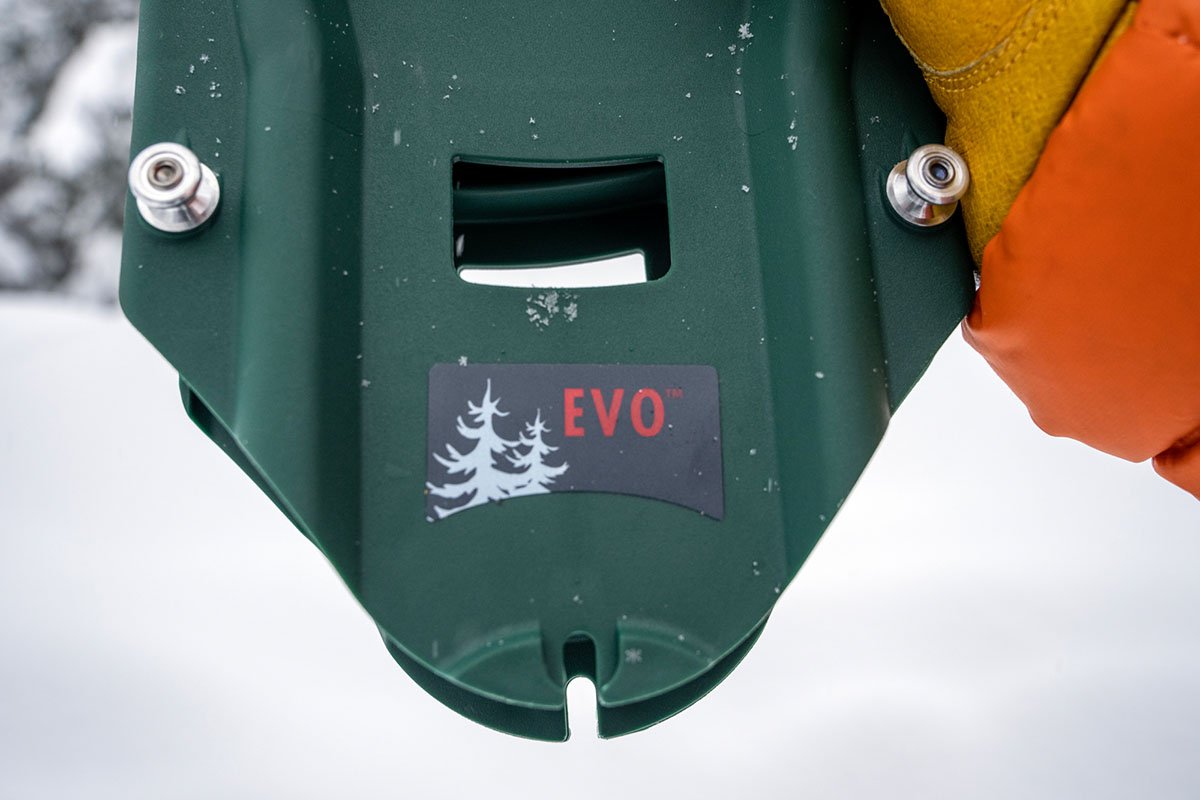
EVA Foam
Crescent Moon made waves with the introduction of its EVA foam snowshoe. Unlike hard plastic or aluminum frame models, the unique Eva is built with two layers of foam—a softer compound on the top for shock absorption and a firm layer on the bottom for toughness. We did have some initial concerns about durability, but our pair has held up well through more than a season of use. The design is geared towards beginners and the lack of a crampon underfoot does impact traction, but it has a nice cushioned feel that is noticeably quieter than a traditional snowshoe when walking on firm or icy snow. Overall, we think Eva’s foam build has a lot of promise and could be a sign of things to come in the industry.
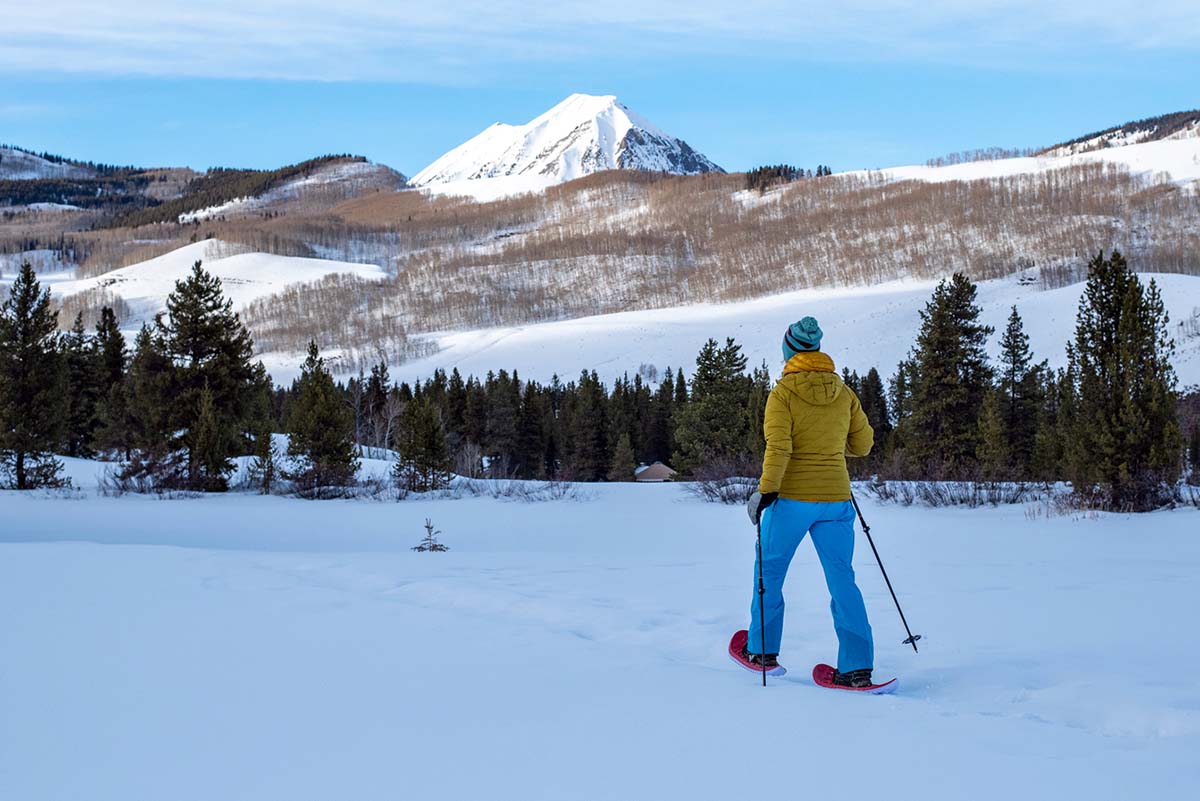
Heel Lift (Climb) Bars
Most high-end trail and nearly every backcountry snowshoe come with a heel lift, also known as a riser. The feature is exactly as it sounds: a single metal bar under your heel that can be raised and locked into place for climbs. The raised bar plays the role of a rigid mountaineering boot, keeping you from dropping your heel while climbing up a sustained grade. The benefit of this feature is reduced calf fatigue, but is it really worth it? Some companies like Crescent Moon were reluctant to include them in their lineup because they determined that most users don’t really need them. But customer demand has remained strong, and even Crescent Moon now offers a heel lift as an add-on for most models in their lineup.
In our experience, heel lift bars have come in handy a couple of times during long climbs, say a spring snowshoe to Camp Muir on Mount Rainier. But for most uses we don’t bother. Unless the hill is steep and will remain steep, it’s just not worth the effort to reach down to raise and lower the bar. A grippy snowshoe and poles play a much greater role in making climbing easier, and therefore we feel that this feature is overrated. Helpful on occasion: yes. Imperative? Certainly not.
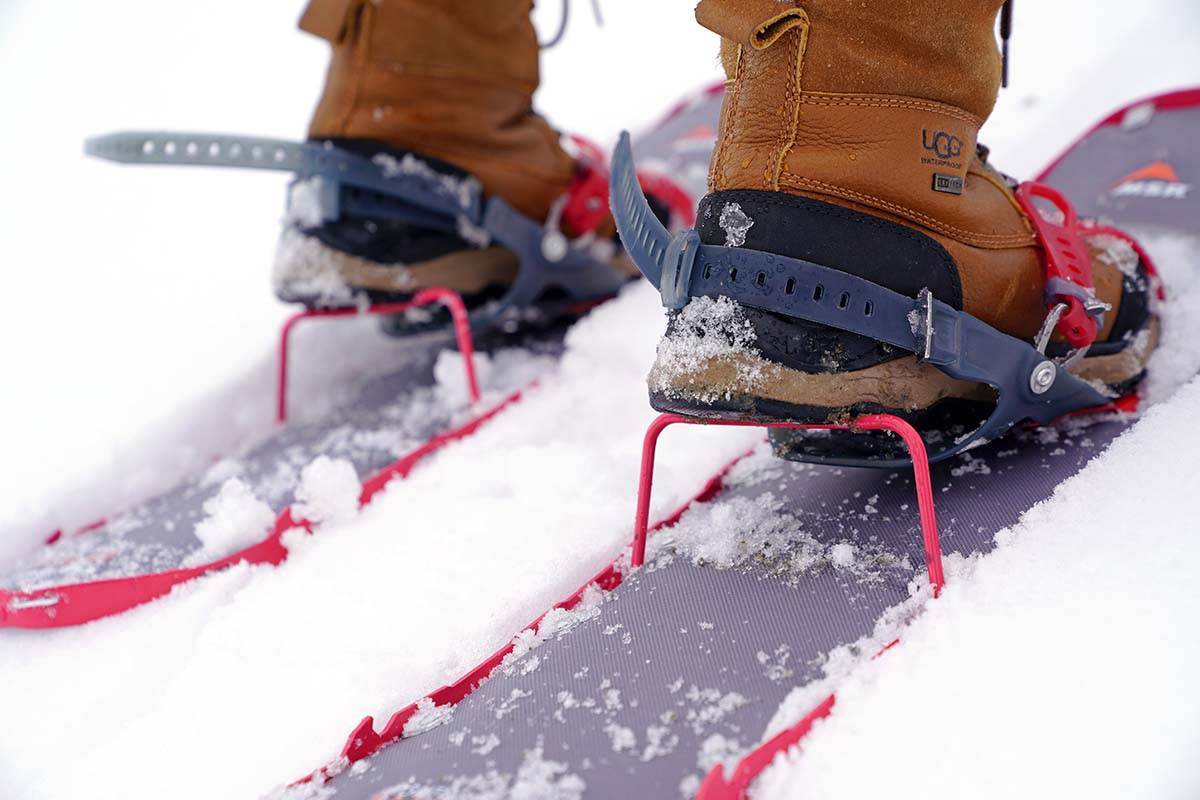
Flotation Tails
One of our favorite snowshoe accessories—and an underrated one at that—are the additional snowshoe tails offered with MSR snowshoes. These add-ons are available for their Evo, Revo, and Lightning lines and are a great way to get all-in-one functionality out of a single pair of snowshoes: Throw on the tails for greater flotation in the soft stuff and stuff them away in your pack when you're traveling over firm snow. They’re ideal for places like the Pacific Northwest or Colorado when snow conditions can vary dramatically throughout the season, so it's no surprise that Seattle-based MSR is leading the charge.
Additional Add-Ons
In addition to heel lifts and tails, several manufacturers offer repair kits and other extras that may prove useful. MSR’s offerings are fairly extensive, from a backpack that’s specifically designed for carrying snowshoes to a handy maintenance kit and replacement straps, strap keepers, and mesh for their Paragon and Paraglide bindings. Crescent Moon also has a few add-ons, including small and large snowshoe carry bags, neoprene booties, and repair parts. Finally, for those inclined to DIY, TSL sells crampons and spikes that you can install on many of their snowshoes to boost grip—just make sure to check compatibility ahead of time.
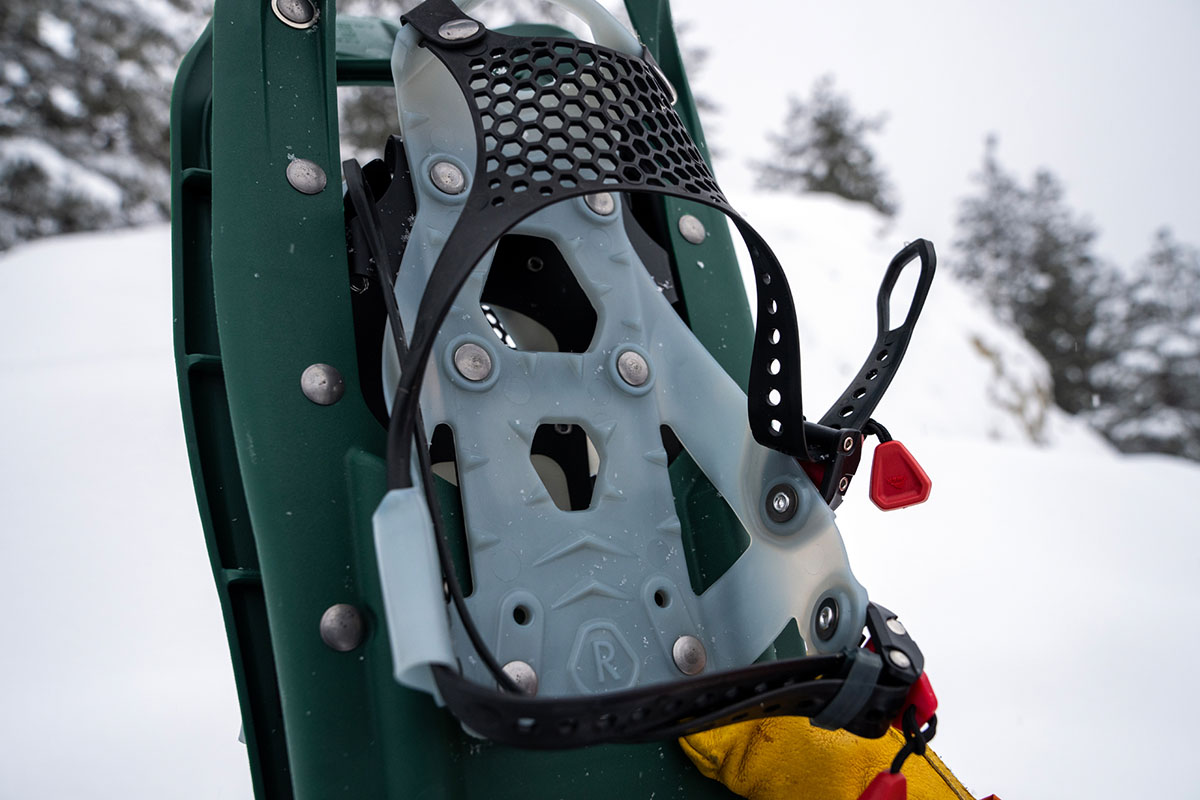
Many hikers choose to hit the trail without trekking poles, but what about snowshoeing? Our short answer to the "Do I need poles?" question is yes: In snow in particular, poles increase stability and make uphill and downhill travel much easier. Even though snowshoes themselves have a wide base, it’s easy to get off balance and take little tumbles. And the good news is that most snowshoers also hike, so it’s fairly common that they already own a pair of quality trekking poles for those purposes.
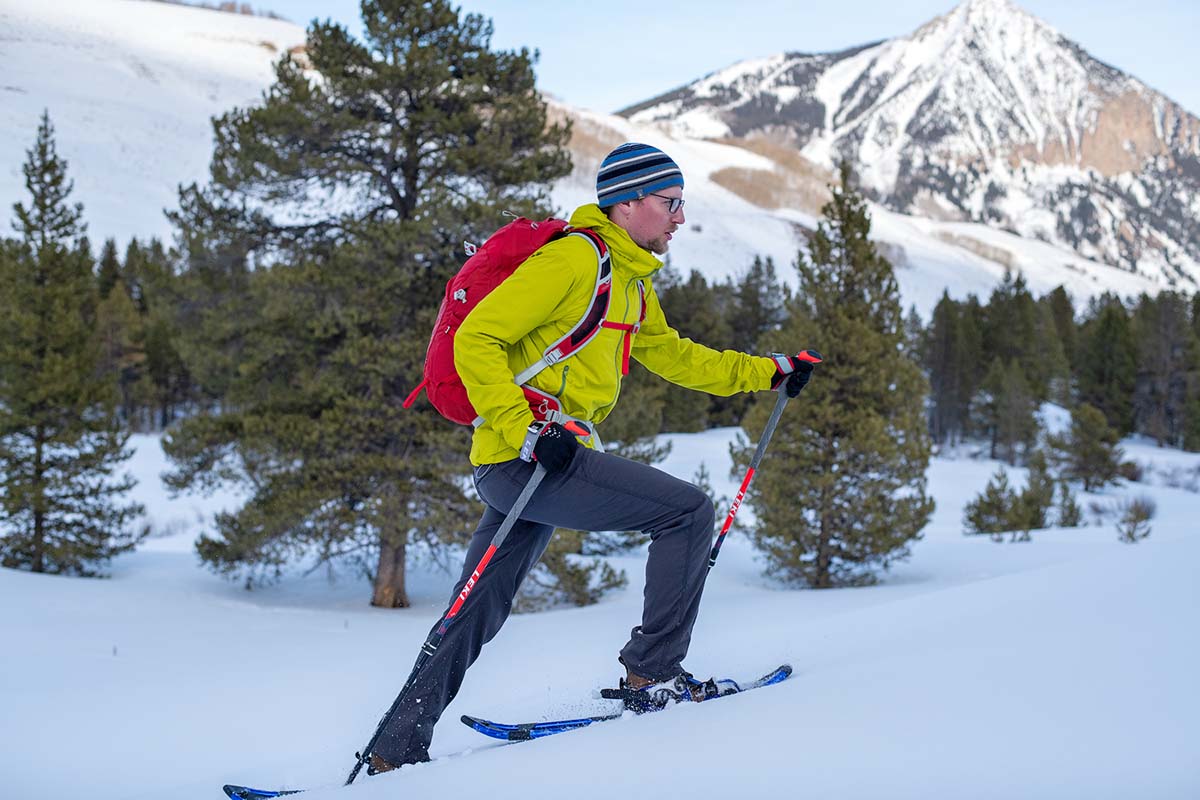
If you already have trekking poles, you'll want to pick up a pair of snow baskets that are specifically designed to fit with your make and model. If you need new sticks, we’re big fans of Black Diamond and MSR, and our favorite model for 4-season use is the Black Diamond Alpine Carbon Cork, which boasts a sturdy design that isn’t prone to flexing under heavy strain and is compatible with both trekking and powder baskets for year-round use (the latter are sold separately). Should you want a more affordable option or prefer to do some further research, we’ve compiled a complete list of the best trekking poles.
Most snowshoers will be comfortable with their regular waterproof hiking boots and a pair of warm wool socks (think medium thickness rather than your lightweight summer hikers). If you’re looking at the running models, then a pair of waterproof trail running shoes should do the trick. With high levels of exertion in moderate temperatures in the 20s and 30s Fahrenheit, these types of footwear are all that most people need. But if you’re snowshoeing in truly cold conditions (or are prone to running a bit cold), the alternative is a lightly insulated winter boot (the Merrell Thermo Chill is a fine choice for these purposes). We don’t recommend using a full-on winter boot like the Sorel Caribou for anything except very short walks—they’re too cumbersome and often far too warm.
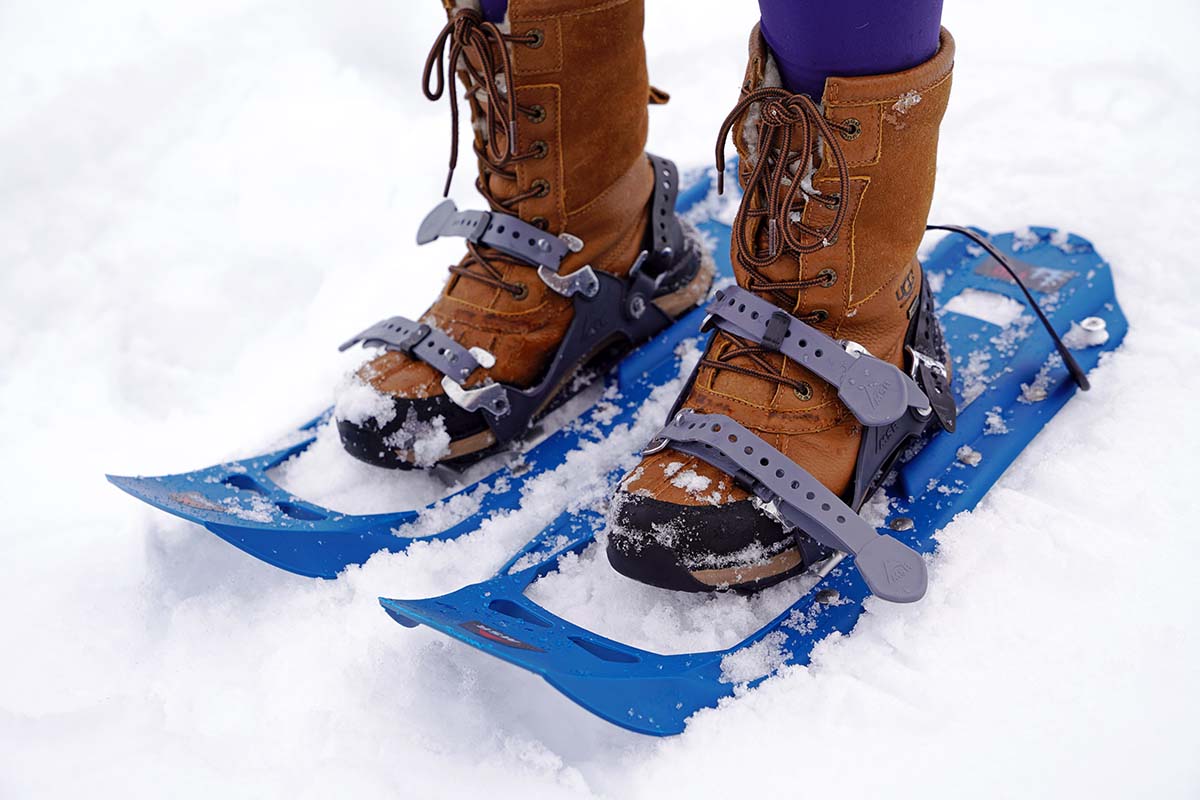
Most snowshoe manufacturers make a unisex model and a corresponding women’s version that may appear to be the same exact snowshoe with a splash of color (where applicable, we've listed these with our picks above). But take heart: Most these models have undergone some changes. First and foremost, women’s snowshoes are shorter. Rather than a 25-inch length being the standard size "small," women’s models start at about 23 inches. The shape also is different, tapering in at the back of the snowshoe to accommodate a woman’s stride that typically is a little shorter. Finally, the bindings are designed to accommodate smaller footwear. It all adds up to a more customized fit that will suit most women better than opting for the unisex (men’s) model.
If you’re just getting into snowshoeing, it can make sense to buy an all-in-one kit that includes poles and other accessories, and the good news is that many of the designs above are offered in prepacked setups. An option like the Yukon Charlie's Advanced Kit has a lot of appeal from a value and convenience perspective: For around $150 (on Amazon at the time of publishing), you get snowshoes, adjustable poles, and a carrying case in one fell swoop. Other popular starter kits include Atlas’ Helium-Trail Snowshoe Kit ($220) and MSR’s Evo Trail kit ($290), which comes with their Evo snowshoes, DynaLock Trail poles, and carry bag with a removable foam seat. Those who already own poles will likely be better off purchasing snowshoes separately, but for beginners that want to remove any guesswork, a prepacked kit is hard to beat.
Outside of poles, one of the most common snowshoe accessories that folks overlook is the trusty gaiter. Typically associated with mountaineering, these waterproof and tough leg protectors are in fact great for snowshoeing. Not only do they keep snow from sneaking through the opening between your pant leg and your boots, they also help protect your pants should you catch a crampon or other sharp object. For most uses a mid-range model should treat you really well. Our favorite model is the Outdoor Research Helium for their tough and waterproof yet lightweight design. And for serious backcountry use, look to OR's Crocodile gaiters.
Back to Our Top Snowshoe Picks Back to Our Snowshoe Comparison Table